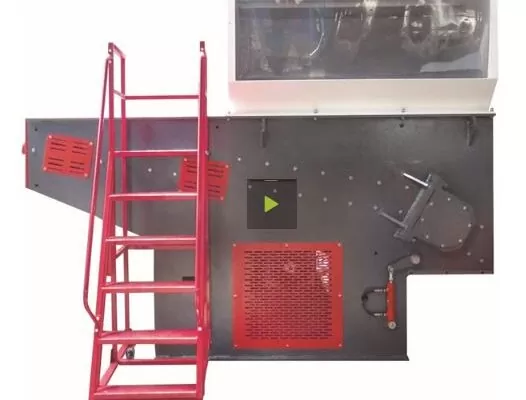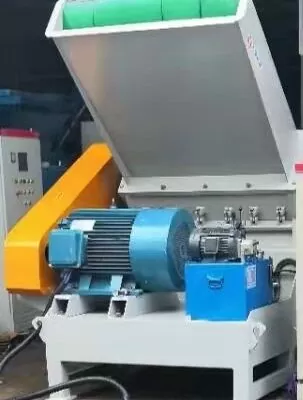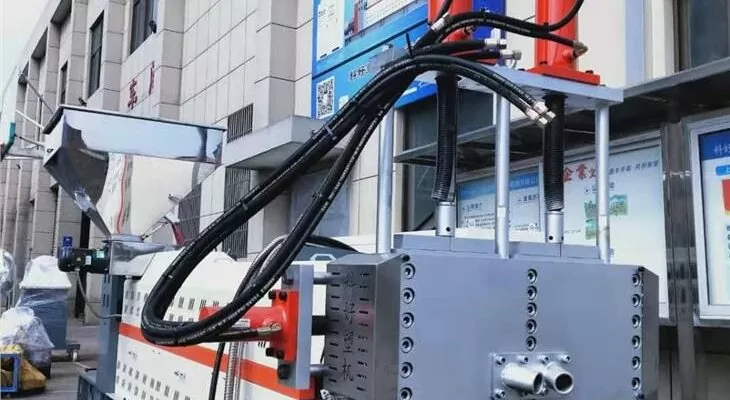I was frustrated. In our industry, plastics are everywhere, yet processing them was a constant headache. I struggled with inefficiencies and wasted resources. Then I discovered the magic of the plastic extruder. It transformed raw plastic into useful products. I realized it was the answer to my manufacturing woes. This machine solved my production problems with precision and speed. It turned a messy challenge into a streamlined process that saved time and money. My journey with extruders changed my business forever.
I quickly learned that a plastic extruder is the heart of our production process. It melts raw plastic pellets and forces them through a die to create continuous profiles or sheets. This process, known as the extrusion process, is efficient and reliable. With the extruder, I can produce everything from pipes to films. It offers consistency, quality, and speed. I have witnessed its impact firsthand in my own business, Amige, where innovation meets practicality.

I invite you to join me on this exciting ride. Every detail about extruders is a step towards mastering plastic manufacturing.
How Does a Plastic Extruder Work?
I often get asked, “How does this machine really work?” The answer lies in a simple yet brilliant process. First, plastic pellets are fed into the extruder. They move through a heated barrel. The barrel’s temperature gradually melts them. I watch with fascination as solid plastic transforms into a fluid state. Every inch of the extruder is engineered for efficiency. It ensures that the melting is uniform, which is crucial for quality production. For more detailed technical data, you might want to check out specialized resources.
The magic continues as the molten plastic travels to the die. Here, it is forced out in a specific shape. The design of the die is vital. It determines the final product’s form—whether it is a pipe, a film, or a sheet. I’ve seen extruders create intricate profiles that even impress seasoned engineers. This step is where precision engineering meets high-grade materials. The process is both art and science, a synergy that drives our industry forward.
What Are the Key Components of a Plastic Extruder?
I take pride in knowing every component of our extruder. The machine is a marvel of modern engineering. It has a heated barrel, a rotating screw, and a precision-engineered die. Each part plays a critical role in ensuring smooth operation. For instance, the screw transports and compresses the plastic. The heated barrel melts it uniformly. These components work in harmony to produce a consistent product every time. I always emphasize the importance of regular maintenance on these parts to prevent downtime. Check out this detailed guide for more on extruder components.
The control system is another vital part. It monitors temperatures and pressures. I appreciate how technology has made it easier to automate the process. Modern extruders feature sensors and digital controllers that ensure optimum performance. I personally love the feedback these systems provide. They allow me to adjust the process in real time. The integration of automation has not only improved efficiency but also safety. In our facility, every component is a testament to innovation and quality.
What Are the Advantages of Using a Plastic Extruder?
I’m excited to share the benefits of using a plastic extruder. One clear advantage is its high production rate. Extruders can run continuously. They produce consistent quality products over long periods. I have witnessed dramatic improvements in throughput. Our facility now operates with minimal downtime. This translates to higher profits and a competitive edge in the market. The efficiency metrics we monitor confirm that extruders are the backbone of modern plastic manufacturing.
Another advantage is design versatility. With a plastic extruder, I can switch dies to produce a wide range of profiles. This flexibility means I can adapt quickly to market demands. Whether it’s tubes, films, or custom shapes, the extruder handles it with ease. I often joke that it’s like having a Swiss Army knife for plastics. Its ability to produce complex shapes with precision makes it indispensable. I encourage fellow manufacturers to explore this innovative technology for their production lines.

What Are the Common Applications of Plastic Extruders?
I’m frequently asked about the real-world applications of plastic extruders. They are used in countless industries. In the automotive sector, extruders produce parts like dashboards and trim. In construction, they create pipes, siding, and insulation. Even the packaging industry benefits from extruded films and sheets. Every day, I see these products making a difference in our lives. The range of applications is vast and growing. For instance, new market trends show an increased demand for lightweight, durable materials made via extrusion.
I am also proud to mention that extruders play a key role in the renewable energy sector. They produce components for solar panels and wind turbines. This connection between technology and sustainability is close to my heart. In our own company, Amige, we continually invest in research and development. Our goal is to push the boundaries of what extruders can do. Their adaptability makes them a cornerstone of modern manufacturing. I am excited by the endless possibilities they offer.
How Do I Maintain and Troubleshoot a Plastic Extruder?
I always stress that proper maintenance is essential. A plastic extruder is a sophisticated piece of machinery. Regular cleaning and lubrication are non-negotiable. I personally ensure that our maintenance team follows a strict schedule. We inspect every part, from the screw to the die, for wear and tear. Preventative maintenance saves us both time and money. It also minimizes unexpected breakdowns. Detailed maintenance logs are kept to track every service. I believe in proactive care rather than reactive fixes.
Troubleshooting is an art in itself. When issues arise, I rely on diagnostic tools and sensor data. The control system offers insights into temperature fluctuations and pressure drops. I always advise my team to act swiftly when anomalies are detected. Quick interventions often prevent minor issues from escalating. In our experience, consistent monitoring and prompt repairs have been the key to long-term success. Sharing knowledge and best practices has built a strong foundation for our operations. Every challenge is an opportunity to learn and improve.
What Does the Future Hold for Plastic Extrusion Technology?
I’m thrilled about the future of plastic extrusion. Innovation is at the core of our industry. New technologies are emerging every day. Advanced sensors, AI integration, and automation are transforming extruders. I see a future where smart extruders optimize their own performance. Real-time data will drive continuous improvement. These advancements will make production even more efficient and environmentally friendly. I love how cutting-edge research is paving the way for a new era in plastic processing.
Sustainability is a big part of our vision. I am committed to reducing waste and energy consumption. The future of extruders involves eco-friendly materials and processes. This not only benefits our business but also our planet. We are investing in renewable energy sources and green technologies. I am confident that our industry will lead the charge towards a more sustainable future. Embracing these innovations is not just a business strategy—it’s a responsibility. Together, we can create a better world.

Diving Deeper: The Science Behind Extrusion
I love explaining the science behind extrusion. The process is rooted in thermodynamics and material science. I often recall my early days when I first learned how heat and pressure can change a material’s structure. It’s both fascinating and complex. I make sure to share this knowledge with my team at Amige. Understanding the science helps in troubleshooting and optimizing production. For anyone interested in the technical details, I recommend checking out this comprehensive study on thermoplastic behavior.
When I explain it to clients, I use simple analogies. Imagine squeezing toothpaste out of a tube. That’s how an extruder works. The plastic is pushed out in a continuous stream, forming a uniform product. It’s an elegant blend of art and engineering. I’m passionate about demystifying these concepts. It makes the technology accessible and inspires innovation in every corner of our operations.
Overcoming Challenges in Plastic Extrusion
I have faced many challenges in the plastic extrusion business. Machine malfunctions and material inconsistencies can disrupt production. I’ve had sleepless nights worrying about potential downtime. However, each challenge taught me something valuable. By investing in high-quality equipment and skilled technicians, I turned setbacks into learning opportunities. I always emphasize the importance of resilience and adaptability in my leadership. Detailed industry reports show that overcoming these challenges is key to staying competitive.
One memorable incident involved a sudden drop in product quality. I immediately gathered my team for an emergency review. We discovered that a minor sensor error was causing major issues. Quick thinking and prompt action saved our production line. It was a learning moment that reinforced the need for vigilance. I now use these experiences to refine our processes continuously. Every challenge is a stepping stone to a more robust system.
How I Leverage Technology for Better Extrusion Outcomes
At Amige, I embrace technology with open arms. Innovations in control systems and sensors have revolutionized how we operate our extruders. I use advanced software to monitor performance and detect potential issues before they become serious. This proactive approach has improved our production quality significantly. The integration of digital monitoring systems allows me to run a tighter ship. It’s all about combining human expertise with smart technology.
I also invest in training programs. My team and I continuously update our skills. We attend workshops, webinars, and trade shows. Staying current with technology trends is crucial. This commitment to learning has paid off in spades. It ensures that our extruder operations are efficient, safe, and sustainable. I am proud to lead a team that values both innovation and tradition. Together, we are building a future where technology and craftsmanship coexist harmoniously.

My Personal Journey with Plastic Extruders
I remember my first encounter with a plastic extruder. It was both intimidating and fascinating. I had little knowledge, but I was eager to learn. I spent hours studying the machine’s operations and understanding its intricacies. That day, I fell in love with the technology. It wasn’t just about machinery—it was about transforming raw materials into valuable products. I realized that mastering this technology was key to success in our industry. Every day since has been an adventure filled with learning and growth. For more insights, check out this personal account.
Over the years, I’ve built a reputation as an expert in plastic extrusion. My passion for innovation has driven our company forward. I share my journey openly because I believe in the power of knowledge. My experiences have taught me that persistence, curiosity, and a willingness to adapt are essential. I encourage others to dive into the world of plastic extrusion. It’s a journey full of challenges, rewards, and endless opportunities to innovate.
What I’ve Learned About Innovation in Extrusion
Innovation is at the core of everything I do. I constantly explore new methods to improve our extruder technology. My team and I work tirelessly to enhance performance and reduce waste. We experiment with new materials and refine our processes. Every innovation is a step towards a more efficient and sustainable production line. Detailed innovation metrics support the positive changes we’ve achieved. I find immense satisfaction in turning creative ideas into practical solutions.
Our innovation efforts are not just about technology. They also involve fostering a culture of continuous improvement. I encourage every member of our team to share ideas. We conduct regular brainstorming sessions and review meetings. This collaborative spirit is what drives us forward. I firmly believe that great ideas can come from anywhere. Together, we are paving the way for a brighter, more innovative future in plastic extrusion.
Embracing Sustainability in Plastic Extrusion
Sustainability is a subject close to my heart. I am deeply committed to reducing our environmental footprint. Plastic extrusion technology has evolved to become more eco-friendly. I actively seek ways to recycle waste and optimize energy use. We implement sustainable practices in every step of the extrusion process. For example, our sustainability initiatives include energy recovery systems and waste minimization programs. It’s a win-win situation for our business and the planet.
I also work with suppliers and partners who share my commitment to the environment. Together, we invest in research to develop biodegradable materials and eco-friendly additives. I’m proud to say that our efforts are making a real difference. Sustainability isn’t just a buzzword—it’s a guiding principle in everything we do at Amige. I believe that by embracing sustainability, we can drive innovation while protecting our planet.
Conclusion
In a nutshell, plastic extruders are transformative. They drive efficiency, innovation, and sustainability. I am proud to lead this exciting industry. Join me as we shape the future of plastic processing.
